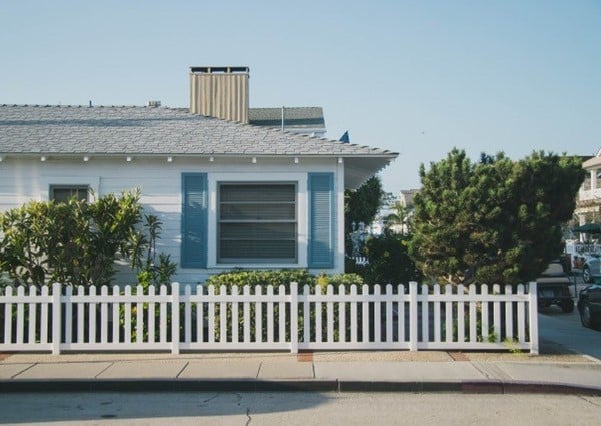What is Transfer Duty?
I f you've been thinking about buying a home, you probably have pages and pages of lists, plans, and documents to help you prepare for your home ownership journey. But have you factored in transfer duty?
f you've been thinking about buying a home, you probably have pages and pages of lists, plans, and documents to help you prepare for your home ownership journey. But have you factored in transfer duty?
Transfer duty, also known as stamp duty, is a tax that you pay when you buy a property. Transfer duty considers either the property’s purchase price or its current market value, whichever is higher.
Each state has different requirements, charges, and exemptions, which can make it hard calculate. Depending on the type of property you are buying, or whether you are a first home buyer, transfer duty rates will differ too. In this guide, we’ll go through how transfer duty works in New South Wales and in Queensland, and some of the differences between the states if you've bought a property before, if you're a first home buyer, and if you're looking for an investment property.
How is transfer duty calculated?
In both New South Wales and Queensland transfer duty is based on either the purchase price of your property or its market value, whichever is higher. In Queensland, this is also referred to as the dutiable value of your property.
If you don't qualify for any concession schemes, you can start by looking at the standard transfer duty rates in New South Wales and Queensland.
To help calculate your transfer duty, we provide a stamp duty calculator that can help you get started! Otherwise, both the New South Wales government and Queensland government provide transfer duty calculators on their websites. Keep in mind that these calculators should be used as guides only, and may not reflect the full amount of transfer duty you may owe.
In these next few sections, we'll explain some of the transfer duty schemes available in New South Wales and Queensland, and their eligibility criteria.
Transfer duty in NSW
First Home Buyer Choice (FHBC)
First Home Owners Grants and Schemes - A Guide to Home Ownership Affordability
If you purchased your home from the first of July onwards you won't be able to access this scheme. Instead, you may be eligible for the First Home Buyers Assistance Scheme (FHBAS) which we'll discuss below.
Changes to the First Home Buyers Assistance Scheme (FHBAS)
The government recently announced changes to the First Home Buyers Assistance Scheme (FHBAS), which came into force on the first of July 2023.
One of these changes is that if you purchase a property worth up to $800,000, you won’t have to pay any transfer duty. If you purchase a property worth between $800,000 and $1 million, you’ll be eligible to receive transfer duty concessions. If you're purchasing vacant land, you'll be exempt from paying transfer duty if your property is worth up to $350,000, and you may receive a concession if it's worth between $350,000-$450,000.
To qualify for the scheme, you will have to meet the following requirements:
- Be an individual (not a company) over 18 years old;
- You or at least one person you are buying with must be an Australian citizen or permanent resident;
- You and anyone you are buying with must not have previously owned or co-owned residential property in Australia, and have never received a first home buyer exemption or concession; and
- You have to move into your property within 12 months of buying it, and live there continuously for 12 months.
These changes apply to both new and existing homes, and vacant land. More information about the scheme can be found on the NSW government’s website.
Standard transfer duty rates
If you are not eligible for either of the schemes we mentioned earlier, the standard transfer duty rates will apply:
| Property value | Transfer duty rate |
| $0 to $15,000 | $1.25 for every $100 (minimum $10) |
| $15,000 to $32,000 | $187 plus $1.50 for every $100 over $15,000 |
| $32,000 to $87,000 | $442 plus $1.75 for every $100 over $32,000 |
| $87,000 to $327,000 | $1,405 plus $3.50 for every $100 over $87,000 |
| $327,000 to $1,089,000 | $9,805 plus $4.50 for every $100 over $327,000 |
| Over $1,089,000 | $44,095 plus $5.50 for every $100 over $1,089,000 |
Transfer duty exemptions in NSW
From the first of July 2023, if you meet the requirements of the FHBAS you won’t have to pay any transfer duty if your new or existing home is valued at $800,000 or less, or your vacant land is worth $350,000 or less.
If you purchased your home before the first of July you may be exempt from paying transfer duty through the FHBC, but you’ll have to pay an annual property tax instead.
Transfer duty in QLD
Residential properties
 In Queensland, there are three different transfer duty concession schemes for residential properties: the home concession, first home concession, and the first home vacant land concession.
In Queensland, there are three different transfer duty concession schemes for residential properties: the home concession, first home concession, and the first home vacant land concession.
To be eligible for any of these schemes, you must meet the following requirements:
- Be an individual (not a company) over 18 years old;
- Move into your home within one year of purchasing. In order to receive the full concession, you must not sell, lease, or otherwise dispose of your property within one year of living there. If you do, you may still be eligible for a partial concession.
More information on these schemes can be found on the Queensland government’s website.
Home concession
This concession is a discounted transfer duty rate that applies for part of the value of your property. Unlike the other concessions, you don’t have to be a first home buyer to qualify. The Queensland government provides the following table listing the duty rates under this concession:
| Purchase price/value | Duty rate |
| Not more than $350,000 | $1.00 for each $100 or part of $100 |
| More than $350,000 to $540,000 | $3,500 + $3.50 for every $100, or part of $100, over $350,000 |
| $540,000 to $1,000,000 | $10,150 + $4.50 for every $100, or part of $100, over $540,000 |
| More than $1,000,000 | $30.850 + $5.75 for every $100, or part of $100, over $1,000,000 |
Let's work through an example!
Let's say you buy a home valued at $480,000, which falls into the $350,000-$540,000 range. This means you'll have to pay $3,500 in transfer duty plus $3.50 for each $100 over $350,000.
This leaves us with $3,500 + $4,550, meaning our transfer duty comes to $8,050.
First home concession
If you are a first home buyer you can also apply for the first home concession. This concession is an amount you can deduct from the transfer duty you owe, and in some cases could result in you not paying any transfer duty! The following table is provided by the Queensland government:
| Purchase price/value | Concession |
| Up to $504,999.99 | $8,750 |
| $505,000 to $509,999.99 | $7,875 |
| $510,000 to $514,999.99 | $7,000 |
| $515,000 to $519,999.99 | $6,125 |
| $520,000 to $524,999.99 | $5,250 |
| $525,000 to $529,999.99 | $4,375 |
| $530,000 to $534,999.99 | $3,500 |
| $535,000 to $534,999.99 | $2,625 |
| $540,000 to $544,999.99 | $1,750 |
| $545,000 to $549,999.99 | $875 |
| $550,000 0r more | Nil |
Let's continue the example we started earlier, where we ended up paying $8,050 in transfer duty.
As our property was worth less than $504,999.99, we can subtract $8,750 from the transfer duty we were supposed to pay ($8,050). This leaves us with no transfer duty to pay!
First home vacant land concession
Just like the first home concession, the vacant land concession is an amount that you can deduct from the transfer duty you owe. The only differences are that the rates are slightly different, and this concession only applies to vacant land. The following table is provided by the Queensland government:
| Dutiable value of the first home vacant land | Concession |
| Not more than $250,000 | 100% of transfer duty |
| More than $250,000 to $259,999.99 | $7,175 |
| $260,000 to $269,999.99 | $6,700 |
| $270,000 to $279,999.99 | $6,225 |
| $280,000 to $289,999.99 | $5,750 |
| $290,000 to $299,999.99 | $5,275 |
| $300,000 to $309,999.99 | $4,800 |
| $310,000 to $319,999.99 | $4,325 |
| $320,000 to $329,999.99 | $3,850 |
| $330,000 to $339,999.99 | $3,375 |
| $340,000 to $349,999.99 | $2,900 |
| $350,000 to $359,999.99 | $2,425 |
| $360,000 to $369,999.99 | $1,950 |
| $370,000 to $379,999.99 | $1,475 |
| $380,000 to $389,999.99 | $1,000 |
| $390,000 to $399,999.99 | $525 |
| $400,000 or more | No concession |
Investment properties
Factors to Consider About Investment Property Affordability
| Dutiable value | Duty rate |
| Not more than $5,000 | Nil |
| More than $5,000 up to $75,000 | $1.50 for each $100, or part of $100, over $75,000 |
| $75,000 to $540,000 | $1,050 plus $3.50 for each $100, or part of $100, over $540,000 |
| $540,000 to $1,000,000 | $17,325 plus $4.50 for each $100, or part of $100, over $540,000 |
| More than $1,000,000 | $38,025 plus $5.75 for each $100, or part of $100, over $1,000,000 |
Transfer duty exemptions in QLD
There are certain transactions where you won't have to pay transfer duty in Queensland:
- Death of a property owner – You won’t have to pay transfer duty on a deceased person’s property if you were a beneficiary to their will, or were a joint owner.
- Matrimonial exemptions – You won’t have to pay transfer duty on transactions involving the Family Law Act or Property Law Act, or transactions involving a court order, divorce order, or decree of nullity.
- Home or property owner – If you transfer an interest of your property to your spouse, or there is a change in tenure (for example going from joint tenants to tenants in common), you may be exempt from paying transfer duty. You may also be exempt if you purchase a manufactured home under a site agreement.
In addition to these, if you apply the home concession and first home concession to a property worth less than $500,000, you won’t have to pay any stamp duty.
Steps for lodging transfer duty
 Once you've done your research and figured out how much transfer duty you'll likely owe or if you qualify for any concessions, it's time to lodge!
Once you've done your research and figured out how much transfer duty you'll likely owe or if you qualify for any concessions, it's time to lodge!
In New South Wales, a solicitor or conveyancer can lodge transfer duty on your behalf. They may also be able to help you navigate any concessions or exemptions you may be entitled to. Transfer duty must be paid within three months of signing a contract of sale, unless you are buying off the plan. More information on applying for the FHBC and FHBAS can be found on the government's website.
In Queensland, transfer duty must be paid within 30 days of signing a contract or when a court order is made, and there is no separate application process if you want to claim any of the concessions. You can lodge transfer duty on your own, or you can work with a solicitor or self-assessor. More information about lodging can be found on the government's website.
This article is intended to provide general information of an educational nature only. This information has been prepared without taking into account your objectives, financial situation or needs. Therefore, before acting on this information, you should consider its appropriateness having regard to these matters and the product terms and conditions. Terms, conditions, fees, charges and credit criteria apply. Information in this article is current as at the date of publication.



